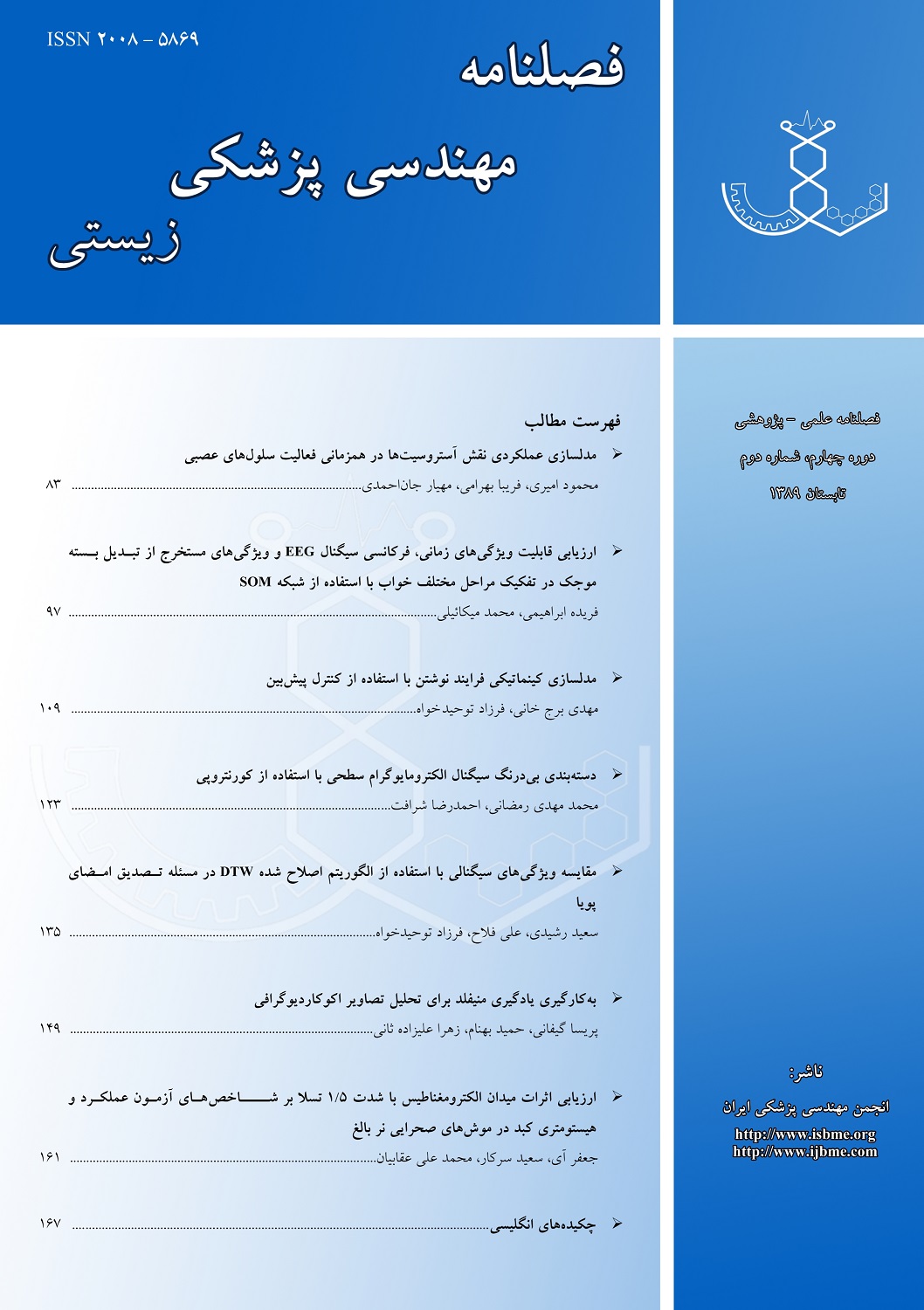نوع مقاله : مقاله کامل پژوهشی
نویسندگان
1 دانشجوی دکترا (بیوالکتریک)، دانشکده مهندسی برق و کامپیوتر، پردیس دانشکدههای فنی، دانشگاه تهران
2 استادیار، دانشکده مهندسی برق و کامپیوتر، قطب کنترل و پردازش هوشمند، پردیس دانشکده های فنی، دانشگاه تهران
3 استاد، مرکز تحقیقات علوم اعصاب و گروه فیزیولوژی، دانشکده پزشکی، دانشگاه علوم پزشکی شهید بهشتی
چکیده
در این مقاله، به مدلسازی عملکردی نقش آستروسیتها که دسته مهمی از سلولهای گلیال به شمار میروند به عنوان تنظیم کنندههای سیناپسی در همزمان شدن فعالیت سلولهای عصبی پرداخته میشود. ایده اصلی استفاده همزمان از مدلهای جمعیت نورونی کورتیکال و تالاموکورتیکال ارائه شده توسط سافژینسکی و همکاران (2004) با در نظر گرفتن ایده بازخورد داخلی مطرح شده بهوسیله آیزمیدیسو همکاران (2009) از یک سو و گنجاندن مدل محاسباتی آستروسیتها در این مدلها، از سوی دیگر است. در همین راستا با گنجاندن نقش آستروسیتها در تنظیم و کنترل فعالیت سیناپس؛ مدلهای کورتیکال و تالاموکورتیکال منطبق بر واقعیت فیزیولوژی توسعه داده شده و تکمیل میشوند. به این ترتیب عملکرد آستروسیتها در حالت طبیعی (سالم) و بیماری (نقص درانجام عملکرد خود) در همزمانسازی فعالیت جمعیتهای نورونی بررسی میشود. نتایج شبیهسازیها نشان میدهد که آستروسیتهای سالم با پایش درست فعالیت سیناپسی و اعمال سیگنال کنترلی مناسب میتوانند تغییرات ورودی تحریکی به سلولهای عصبی را تا حد زیادی جبران کنند. در حالی که آستروسیتهای بیمار نمیتوانند در تنظیم فعالیت سیناپسی وظیفه خود را به درستی انجام دهند و در نتیجه نمیتوانند از بروز همزمان شدن غیرطبیعی و بیش ازحد سلولهای عصبی جلوگیری کنند. بنابراین با توجه به نتایج مدلهای تکمیل شده، پیشنهاد میشود که امکان استفاده از مواد مؤثر بر آستروسیتها به عنوان یک کاندید جدید در درمان بیمارهای مرتبط با همزمان شدن غیرطبیعی سلولهای عصبی (همچون بیماری صرع) مورد بررسی بیشتر و عمیقتر قرار گیرد.
کلیدواژهها
موضوعات
عنوان مقاله [English]
Functional Modeling of Astrocytes in Synchronization of Neuronal Cells
نویسندگان [English]
- Mahmoud Amiri 1
- Fariba Bahrami 2
- Mahyar Janahmadi 3
1 PhD Candidate, School of Electrical and Computer Engineering, College of Engineering, University of Tehran
2 Assistant Professor, CICPE, School of Electrical and Computer Engineering, College of Engineering, University of Tehran
3 Professor, Neuroscience Research Center, School of Medicine, Shahid Beheshti University of Medical Sciences
چکیده [English]
Based on the neurophysiologic findings, astrocytes provide not only structural and metabolic supports for the nervous system but also they are active partners in neuronal activities and synaptic transmissions. In the present study, we improved two biologically plausible cortical and thalamocortical neural population models (CPM and TCPM), which were developed previously by Suffczynski and colleagues, by integrating the functional role of astrocytes in the synaptic transmission in the models. In other words, the original CPM and TCPM are modified to integrate neuronastrocyte interaction considering the idea of internal feedback proposed by Iasemidis and collaborators. Using the modified CPM and TCPM, it is demonstrated that healthy astrocytes provide appropriate feedback control for regulating the neural activities. As a result, we observed that the astrocytes are able to compensate for the variations in the cortical excitatory input and maintain the normal level of synchronized behavior. Next, it is hypothesized that malfunction of astrocytes in the regulatory feedback loop can be one of the probable causes of seizures. That is, pathologic astrocytes are not any more able to regulate and/or compensate the excessive increase of the cortical excitatory input. Consequently, disruption of the homeostatic or signaling function of astrocytes may initiate the hypersynchronous firing of neurons. Our results confirm the hypothesis and suggest that the neuronastrocyte interaction may represent a novel target to develop effective therapeutic strategies to control seizures.
کلیدواژهها [English]
- Astrocyte
- Functional modeling
- Epilepsy
- cortical and thalamocortical models
- Neural synchronization

